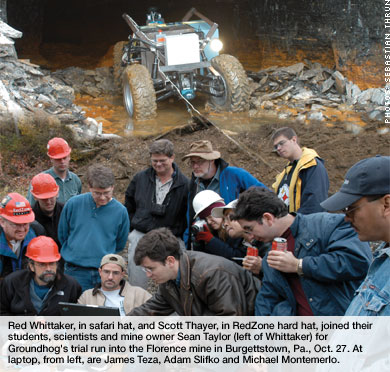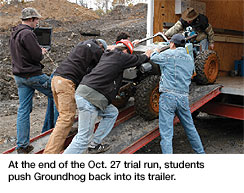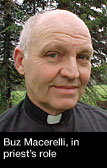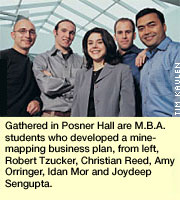 |
|
 |
||||||||
|
|
|
|||||||||
|
 Quecreek Disaster inspires Course Students Really Dig Mine-Mapping Robot Class Red Whittaker's students design, construct and test robots to map abandoned mines and avert mining catastrophes. � By Ruth Hammond
Why bother to sleep, Ling, a senior in electrical engineering, thinks. He decides to work on other homework until it's time to show up. Throughout the fall semester, Ling and Whittaker's other undergraduate and graduate students keep a frantic pace to create robots designed to do what has never been done before: explore abandoned mines whose dangers place them off limits to humans and make both 2-D and 3-D maps of what's inside. Whittaker (E'75, '79) settled on the purpose of his Mobile Robot Development course just 10 minutes before he announced it last August. Weighing on his mind was last summer's Quecreek mine disaster, in which nine Pennsylvania miners were trapped underground for more than three days after they accidentally breached a neighboring mine, unleashing a flood of water. The event took place in Somerset County, 24 miles from Whittaker's cattle farm. If there had been more accurate maps of the neighboring mine, the crisis might have been avoided. "In choosing a topic, I look for something that is a stretch of the technology, something that mixes with the events of our time, something that is real and something that is realistically achievable as a contribution," says Whittaker, a former Marine sergeant and boxer, who is the Fredkin research professor in the Robotics Institute. He doesn't like to contrive problems. "Students know the difference, and so does the world." "The problem really speaks to people, and it gets them excited that they'll be doing something that impacts the world in a positive way," says Scott M. Thayer, a systems scientist in the Robotics Institute and course co-instructor. If there was ever a class that hit the ground running, it's this one. "We are approaching this as a research experiment, akin to the Wright brothers' attempt to fly," Whittaker wrote in an e-mail to university administrators. For the students signing up for the course, it was as if, in 1902, a year before the first flight, they had registered for a class in which they were expected to build and fly their own airplane. The students are developing not just one mine-mapping robot but three. The first, Groundhog, is a 1,600-pound, four-wheeled vehicle that uses lasers to determine distances to surrounding walls, floors and ceilings, cameras to visualize the space and software to build detailed maps from the data. The second, Ferret, is a tubular device that can be lowered through a borehole into a mine opening. A laser scanner at the base of the robot "looks around" the open space, maps it and calculates its volume. Ferret produced 3-D maps of four voids under a residential street in Kansas City, Kan., in January. The third robot, Helix, which was built in a follow-up course this spring, combines the capabilities of Groundhog and Ferret. After being lowered into a mine through a borehole, Helix drives around to explore and map the space, then positions itself to be retrieved by hook through the borehole. Whittaker works his students hard, bolstering them with expressions of faith in their talent. "I commiserate with anyone who's in the gun sights of a team like that," he says of his dozen mobile robot students. "They're very, very good."
Whittaker propels students into action Whittaker announces to the class that he is scheduled to give a presentation on mine mapping at a technical meeting of the Mine Safety and Health Administration in Charleston, W.Va., six days later, on Oct. 29. He asks if they're ready to go into a mine with Groundhog, so he can show a live video feed to his audience of what the robot can do. Sensing hesitance, he has one of them read aloud from the abstract he just submitted to the conference organizers. "The presentation will exhibit live mapping of a mine by a robot to convey the power of the technology in action," the student reads. Everyone stares at the line on the handout. "OK, here's the deal. Once I write that, we can't not do it," Whittaker says. "So there's no question about it. "When are you really going to be ready?" he adds, encouragingly. "You know, when they launch the shuttle, it's never ready. It always has dozens of flaws they know about. They launch anyway." The students discuss everything they need: a booth for the meeting, a satellite truck, computers, cameras, cables, halogen lights, sensors, a trailer. They need an abandoned mine to explore. Whittaker has a good prospect at Burgettstown, 30 miles away, which he plans to check out the next day.
"Everyone understands that win or lose, it's OK," Whittaker says. "How it turns out is how it turns out. But the one thing that's not OK is to not go for it." The pressure is on for everyone, but especially for graduate students Christopher R. Baker (CS'02) and Zachary Omohundro, a mechanical and electrical engineering graduate of Rice University. They've done much of the work on Groundhog, staying up as long as 50 hours at a stretch. Baker does a lot of the building, and Omohundro develops the software. "After about the 20-hour mark, we realize that between the two of us we have one brain working, so we catch each other's mistakes," Baker says. He's exhausted, but if he didn't love the work, "then no one could force me to put in the kind of hours I'm putting in." Neither graduate student interprets Whittaker's reassurance, "Win or lose, it's OK," as an escape clause. "He doesn't mean that," Omohundro says. "He means that you will get it done. He understands that sometimes stuff fails, but you'd better not fail."
Groundhog explores mine mapped 82 years ago The first mine Groundhog maps—the Florence mine, on the property of Mulligan Mine in Burgettstown—hasn't been explored since 1920. Mulligan's owner, Sean Taylor, has a copy of the last map made by humans, 82 years ago, but he doesn't know how the mine might have changed in the intervening years. Until Red Whittaker calls him about sending Groundhog into the mine, its interior seems destined to remain a mystery. Caught up in Whittaker's enthusiasm, Taylor delays coal excavation over the Florence mine and pumps water out of it to accommodate Groundhog. After a successful trial run on Oct. 27, co-instructor Thayer and a team of students and robotics specialists return to the mine early in the morning two days later with Groundhog. Chris Baker's father, general contractor Randy Baker, drives the truck pulling the trailer that holds Groundhog. Also joining the students is Red Whittaker's brother, Chuck Whittaker, who passes out boots, warm jackets and hard hats.
The trailer is equipped with computers, chairs, video cameras, generators, lasers, nuts and bolts, and two items that turn out to be crucial: garbage bags and toilet paper. What's missing is one female coupler. Robotics Institute research engineer James P. Teza performs some last-minute surgery, soldering two cables together, and Groundhog drives down the ramp out of the trailer, approaching the mouth of the mine. Remaining inside the trailer are the computers that will display the maps and images Groundhog sends back from its journey, the same visuals that will be exhibited at the conference in Charleston before and during Whittaker's talk. Using the laser-generated maps as his guide,
Baker steers the robot using the computer's arrow keys to turn right or left and the home key to go straight ahead. To bring the robot to a halt, he hits the space bar. Robotics graduate student Michael S. Montemerlo (E'97), who is not in Whittaker's class, runs the mapping software on an adjacent computer. "We need a glory shot as we're going into the mine," Thayer instructs the crew. The maps Groundhog is generating reveal the height of the roof, where the mine passage narrows and widens, the location of intersections, a small room off the first crosscut and a timber that appears to have fallen from the roof. "That's so much better than a mine map, it's ridiculous," says Taylor, looking over Montemerlo's shoulder. Groundhog's rear camera captures a video shot of three students standing outside the mine holding tethers attached to the robot. The tethers are a precaution so the robot can be hauled out if it gets stuck, since no one would dare go in after it. During the first run, Groundhog makes it 31 meters into the mine, reemerging with its wheels covered in a bright orange muck, evidence of the iron and sulfur in the soil. Around 10:45 a.m., it starts to rain. The 37-degree outdoor temperature affects even the team members inside the unheated trailer, who rub their hands and blow on them to keep their fingers limber enough to type keyboard commands. The outside crew is getting soaked, and so is many thousands of dollars worth of equipment. The students rush to cover their precious Groundhog and other gear with garbage bags. As the rain continues, they worry that the water running off into the mine will get so deep Groundhog will not be able to go far without imperiling its $3,000 lasers. Omohundro rigs up the garbage bags so they can be dragged off Groundhog at the last moment, just before it enters the mine. As a final touch, he wipes the raindrops from the robot's laser scanners and camera lenses with toilet paper. In order to provide a live feed during Whittaker's talk, the team needs to keep the robot running until 1:25 p.m. They have 40 minutes to fill, and Baker is worried that Groundhog's batteries may run down by then. The robot lumbers deeper and deeper into the water of the mine, churning up chunks of shale. Thayer watches the video being beamed to Charleston. "That is beautiful, dude," he says. "Look at the ripples in the water, man. "Groundhog's 21-inch wheels are submerged, reminding the students their robot falls a few design elements short of being amphibious. The screens displaying Groundhog's maps and video go blank, causing a few anxious moments both at mission control and in Charleston, where Whittaker is giving his talk to mining company representatives and government mine safety officials. The team reboots the computers to reestablish contact. Robotics Institute multimedia designer Brian Staszel pushes some buttons on the video control board, and the picture returns. Groundhog is on its way back. Thayer is exultant. "We buried it, dude. The robot was underwater." "Ha, ha, fooled you, I'm a submarine," Baker sings. About 20 feet from the entrance, Groundhog's batteries give out. It halts. With the show in Charleston over, the team can wait for them to recharge before using the arrow and home keys to coax the robot out of the mine. Later, there will be time for sleep and dry clothes. For the moment, a sense of triumph and relief prevails. "Very few of us know what our capacities really are," Whittaker observed, a week before the mission was accomplished. "I'm absolutely sure that the experience of rising to the challenge is at once traumatic and worthy. There's no question that anyone who's involved with this is stretching beyond a prior experience and stepping into the unknown."
> Back to the top > Back to Carnegie Mellon Magazine Home |
|||||||||
|
Carnegie Mellon Home |
||||||||||



 William L. Whittaker's students and colleagues call it "the look": the way he leans forward so intently that, even though he is 6 foot 4, he casts his eyes upward at his audience. This gaze of earnestness and supplication is one that has spurred many students to accomplish more than they thought possible.
William L. Whittaker's students and colleagues call it "the look": the way he leans forward so intently that, even though he is 6 foot 4, he casts his eyes upward at his audience. This gaze of earnestness and supplication is one that has spurred many students to accomplish more than they thought possible.
 Last summer, like the rest of his neighbors in Ligonier, Pa., antiques dealer and painter David M. "Buz" Macerelli (A'75) anxiously awaited the outcome of the Quecreek mining disaster. Would the nine miners trapped below the earth survive?
Last summer, like the rest of his neighbors in Ligonier, Pa., antiques dealer and painter David M. "Buz" Macerelli (A'75) anxiously awaited the outcome of the Quecreek mining disaster. Would the nine miners trapped below the earth survive?
 While Mobile Robot Development students were building their mine-mapping robots in the fall, five students in
While Mobile Robot Development students were building their mine-mapping robots in the fall, five students in